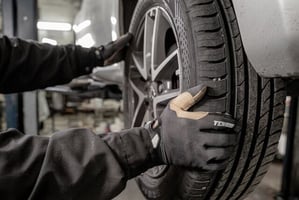Towing large trailers can be stressful if your rig isn’t stable. Trailer sway is a common problem that makes driving unsafe and uncomfortable, especially in windy conditions or on uneven roads. The best way to get a stable ride with large trailers is to use a reliable anti-sway hitch designed to control trailer movement before it becomes dangerous.
The ProPride 3P® hitch uses Pivot Point Projection™ technology to stop trailer sway more effectively than traditional friction hitches. It gives you smoother towing and better weight distribution without drilling or complicated parts. Choosing the right hitch can make your trailer feel much more stable.
Not all hitches perform equally, and a poor choice increases towing anxiety. A safe and well-performing towing setup is essential every time you hit the road. Features like an adjustable hitch bar and one-piece yoke improve stability and help you pick the right solution for your large trailer.
Key Factors for a Stable Ride
To keep your large trailer steady, pay close attention to trailer size and loading, hitch type, and tires. These three areas have a big impact on trailer sway and towing safety.
Trailer Size and Weight Distribution
The size of your trailer affects how it handles. Larger trailers create more wind resistance, which can cause sway. Proper weight distribution is critical. Aim for about 10-15% of your trailer’s total weight pressing down on the hitch.
If too much weight sits at the back, the trailer may fishtail. Too much at the front strains your vehicle’s rear suspension. Use a weight distribution hitch with spring bars if needed to spread the weight more evenly. Always balance heavy items low and centered to improve stability.
Proper Hitch Selection
Choosing the right hitch is vital for a smooth tow. Not all hitches control sway well, especially with large trailers. Many friction hitches only mask sway instead of eliminating it. A premium anti-sway hitch like the ProPride 3P® uses Pivot Point Projection™ technology to create a virtual pivot point and stop sway before it starts.
Look for features like a one-piece yoke for durability and an adjustable offset bar for better alignment. Avoid hitches that require drilling or unreliable strut bars, as they can increase maintenance. The right hitch improves safety and reduces driver fatigue.
Tire Selection and Inflation
Tires support your trailer’s entire weight, so their size, type, and pressure matter. Use tires rated for your trailer’s Gross Axle Weight Rating (GAWR). Avoid cheap, all-season tires that lack sidewall strength or heat resistance.
Keep tires inflated to the manufacturer’s recommended pressure—check regularly. Underinflated tires increase rolling resistance and heat, which can cause blowouts and sway. Overinflated tires reduce grip and lead to a harsher ride. Choose tires designed specifically for trailers; they handle heat and heavy loads better than truck tires.
Essential Equipment for Large Trailers
To keep your large trailer stable, use gear focused on controlling sway, managing weight, and improving braking. Each piece of equipment makes towing safer and smoother, especially with heavy loads.
Sway Control Devices
Sway control devices stop your trailer from wobbling side to side while you drive. Traditional friction-based hitches try to resist sway with pads, but these often wear out or lose effectiveness. Modern anti-sway hitches use advanced technology for better control.
The ProPride 3P® hitch uses Pivot Point Projection™ technology to create a virtual pivot point between your tow vehicle and trailer. This design actively prevents sway instead of just resisting it. The result is a safer and smoother ride, especially in windy conditions or when passing large trucks.
Once trailer sway starts, it can quickly become dangerous. A reliable sway control system reduces anxiety and keeps your trailer following your vehicle’s direction.
Weight Distribution Hitches
Weight distribution hitches spread the trailer’s tongue weight evenly across your tow vehicle and trailer axles. This balance improves steering, braking, and overall handling. Without proper weight distribution, your rear axle may sag, lifting the front wheels and reducing control.
A good weight distribution hitch uses spring bars attached to a frame bracket. These bars push down on your vehicle’s front axle while lifting the trailer’s tongue, leveling both vehicle and trailer.
Look for adjustable options to fine-tune the setup for different trailers or load sizes. A weight distribution hitch works best when paired with an anti-sway system.
Brake Controller Systems
A trailer’s brake controller communicates with your tow vehicle to activate trailer brakes when you slow down. Without this, your trailer can push against your vehicle, causing poor stopping power and increased sway risk.
There are two main types of brake controllers: time-delayed and proportional. Time-delayed systems apply brakes at a fixed rate. Proportional controllers adjust braking based on how hard you press the vehicle brakes, offering more precise control and smoother stops.
Using a brake controller system is critical for heavy trailers. It reduces wear on your tow vehicle’s brakes and improves safety on downhill grades or sudden stops. Match your controller to your trailer’s brake type and ensure proper installation and calibration for the best towing stability.
Driving Tips for Enhanced Stability
Maintaining a stable ride with large trailers depends on managing speed, making smooth lane changes, and handling turns carefully. Each of these actions helps reduce sway and keeps your trailer steady.
Speed Management Techniques
Speed has a big impact on trailer stability. Drive slower than you would with a small load. Ideally, keep your speed under 55 mph, or even lower if wind or road conditions are poor.
Use cruise control cautiously or avoid it. Manual control lets you respond quickly to sway or sudden changes.
Higher speeds increase the chance of trailer sway. Keep a safe distance behind large trucks to avoid their bow waves, which can push your trailer side to side.
Effective Lane Changes
When changing lanes with a large trailer, plan early and signal well in advance. Use your mirrors to check blind spots. Large trailers extend beyond your vehicle’s width, so use extra caution.
Make smooth, steady movements instead of sharp or fast lane changes. This prevents sudden weight shifts that cause sway.
If traffic is heavy, wait for a larger gap to change lanes. Avoid weaving, which increases the load on your hitch and decreases towing stability.
Advanced trailer sway control systems help reduce risk during lane changes by projecting forces away from the vehicle frame, keeping your tow more connected to the road.
Handling Turns and Curves
Take turns slowly and steadily. Fast or sharp turns cause uneven weight distribution and can trigger trailer sway.
When going down curves, slow before the turn instead of braking while turning. Braking in a curve shifts weight forward and sideways, upsetting balance.
Widen your turning radius if possible. Large trailers need extra space to avoid clipping curbs or obstacles.
If you feel sway starting on a curve, gently reduce speed and keep your steering input smooth. The ProPride 3P® hitch’s Pivot Point Projection™ technology helps neutralize these forces by locking side-to-side movement at the coupler for better control.
Maintenance and Safety Checks
Keeping your large trailer stable starts with careful inspection and regular maintenance. These steps help catch potential problems early and keep your towing setup safe.
Pre-Trip Inspection Guide
Before every trip, check key trailer parts to avoid sway and failures. Start with the hitch connection. Make sure the ProPride 3P® hitch is securely locked and the adjustable offset hitch bar is tight. Inspect the frame bracket for cracks or looseness.
Look over the spring bars and control links. They should be free of rust, damage, or bending. Check that the hitch head and hitch box move smoothly with no unusual play. Examine the trailer tires. Proper pressure and good tread reduce sway risk. Test lights, brakes, and safety chains to ensure everything works correctly.
Routine Maintenance Checklist
Regular care keeps your hitch and trailer performing well. Lubricate the one-piece yoke and pivot point projection™ parts according to ProPride’s guidelines. This keeps the virtual pivot point working and prevents wear.
Tighten all bolts on the hitch assembly monthly. Check your trailer’s suspension and weight distribution system for worn parts or loose fittings. Replace damaged spring bars or control links immediately. Keep your tires balanced and aligned to reduce sway and uneven wear.
Record all maintenance to spot trends or recurring issues.
Frequently Asked Questions
When towing large trailers, you need to know how vehicle limits, loading, and sway factors affect stability. Making the right adjustments and understanding key measurements help you maintain a smooth, safe ride.
What determines the maximum trailer length I can pull with my vehicle?
The maximum trailer length depends on your vehicle’s towing capacity and local laws. Check your vehicle’s manual for its maximum tongue weight and gross trailer weight ratings.
Length restrictions may also come from state or highway regulations, so confirm legal limits where you plan to drive.
How can I obtain a smooth ride experience when pulling a large trailer?
Using a premium anti-sway hitch like the ProPride 3P® can significantly improve ride stability. It reduces trailer sway by creating a virtual pivot point, which controls movement more effectively than friction-based hitches.
Balancing weight distribution and adjusting your hitch height also helps maintain a smooth towing experience.
What factors contribute to trailer sway and how can I minimize it?
Trailer sway is caused by wind, uneven loads, and sudden driving movements. Passing large vehicles can push air into your trailer, increasing sway.
To minimize sway, use an advanced sway control hitch, keep your speed steady, and avoid quick turns or sharp braking.
Are there specific strategies to load a trailer to reduce sway issues?
Yes. Place about 60% of the trailer’s weight toward the front, ahead of the axles. Keep heavy items low and centered to lower the center of gravity.
Distributing weight properly prevents the trailer from fishtailing and aligns force better across the axles.
Can adjusting axle positions on a semi trailer affect its stability on the road?
Moving axles changes weight distribution and affects stability. Axles too far back or forward can cause uneven load on tires and suspension.
Proper axle placement helps balance weight, reducing sway and improving handling on turns and bumpy roads.
Is there a way to calculate the ideal placement for tandem trailer axles?
Yes, but you need precise weight measurements. The goal is to spread the trailer’s load evenly across all axles.
Consult detailed guidelines or a professional to measure tongue weight and axle load. This helps keep your trailer balanced and stable during transit.


